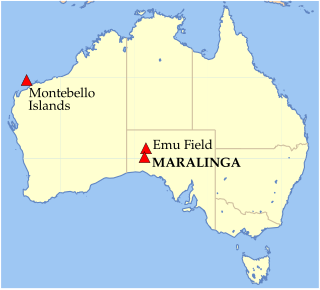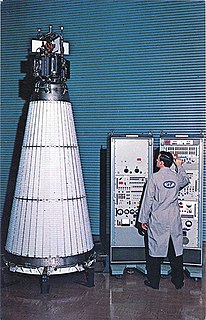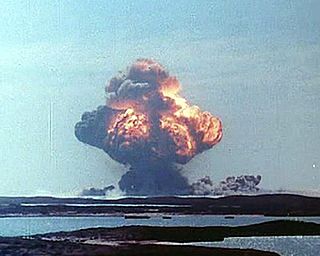Smiling Buddha was the assigned code name of India's first successful nuclear bomb test on 18 May 1974. The bomb was detonated on the army base Pokhran Test Range (PTR), in Rajasthan, by the Indian Army under the supervision of several key Indian generals.

Enewetak Atoll is a large coral atoll of 40 islands in the Pacific Ocean and with its 664 people forms a legislative district of the Ralik Chain of the Marshall Islands. With a land area total less than 5.85 square kilometres (2.26 sq mi), it is no higher than 5 meters and surrounds a deep central lagoon, 80 kilometres (50 mi) in circumference. It is the second-westernmost atoll of the Ralik Chain and is 305 kilometres (190 mi) west from Bikini Atoll.

The Montebello Islands, also known as the Monte Bello Islands, are an archipelago of around 174 small islands lying 20 kilometres (12 mi) north of Barrow Island and 130 kilometres (81 mi) off the Pilbara coast of north-western Australia. Montebello is Italian for "beautiful mountain". The islands form a conservation park administered by the Western Australian Department of Environment and Conservation, and it is likely that the shallow waters around them will become a marine conservation reserve. The islands were the site of three nuclear weapons tests by the British military in the 1950s.

Operation Grapple was a set of four British nuclear weapons test series of early atomic bombs and hydrogen bombs carried out in 1957 and 1958 at Malden Island and Kiritimati in the Gilbert and Ellice Islands in the Pacific Ocean as part of the British hydrogen bomb programme. Nine nuclear explosions were initiated, culminating in the United Kingdom becoming the third recognised possessor of thermonuclear weapons and the restoration of the nuclear Special Relationship with the United States with the 1958 US-UK Mutual Defence Agreement.

Maralinga in the remote western areas of South Australia was the home of the Maralinga Tjarutja, a southern Pitjantjatjara people, an Aboriginal Australian people. Maralinga was the site of the British nuclear tests in the 1950s. The site measures about 3,300 square kilometres (1,300 sq mi) in area.

Emu Field is located in the desert of South Australia, at 28°41′54″S132°22′17″E. Variously known as Emu Field, Emu Junction or Emu, it was the site of the Operation Totem pair of nuclear tests conducted by the British government in October 1953.

British nuclear tests at Maralinga were conducted between 1956 and 1963 at the Maralinga site, part of the Woomera Prohibited Area in South Australia about 800 kilometres (500 mi) north west of Adelaide. A total of seven nuclear tests were performed, with approximate yields ranging from 1 to 27 kilotonnes of TNT. Two major test series were conducted at the Maralinga site: Operation Buffalo in 1956 and Operation Antler the following year. Operation Buffalo consisted of four tests; One Tree and Breakaway were detonated on towers, Marcoo at ground level, and the Kite was released by a Royal Air Force (RAF) Vickers Valiant bomber from a height of 11,000 metres (35,000 ft). This was the first drop of a British nuclear weapon from an aircraft.

The United States was the first country to manufacture nuclear weapons and is the only country to have used them in combat, with the separate bombings of Hiroshima and Nagasaki in World War II. Before and during the Cold War, it conducted over one thousand nuclear tests and tested many long-range nuclear weapons delivery systems.

SNAP-10A was a US experimental nuclear powered satellite launched into space in 1965 as part of the SNAPSHOT program. The test marked the world's first operation of a nuclear reactor in orbit, and also the first operation of an ion thruster system in orbit. It is the only fission reactor power system launched into space by the United States. The reactor stopped working after just 43 days due to a non-nuclear electrical component failure. The Systems Nuclear Auxiliary Power Program (SNAP) reactor was specifically developed for satellite use in the 1950s and early 1960s under the supervision of the U.S. Atomic Energy Commission.

The Pacific Proving Grounds was the name given by the United States government to a number of sites in the Marshall Islands and a few other sites in the Pacific Ocean at which it conducted nuclear testing between 1946 and 1962. The U.S. tested a nuclear weapon on Bikini Atoll on June 30, 1946. This was followed by Baker on July 24, 1946.

The W33 was an American nuclear artillery shell, fired from an eight-inch (203 mm) M110 howitzer and M115 howitzer.

The A-35 anti-ballistic missile system was a Soviet military anti-ballistic missile (ABM) system deployed around Moscow to intercept enemy ballistic missiles targeting the city or its surrounding areas. The A-35 was the only Soviet ABM system allowed under the 1972 Anti-Ballistic Missile Treaty. In development since the 1960s and in operation from 1971 until the 1990s, it featured the nuclear-tipped A350 exoatmospheric interceptor missile. The A-35 was supported by the two Dunay radars and the Soviet early warning system. It was followed by the A-135 in the early 1990s.

Operation Mosaic was a series of two British nuclear tests conducted in the Monte Bello Islands in Western Australia on 16 May and 19 June 1956. These tests followed the Operation Totem series and preceded the Operation Buffalo series. The second test in the series was the largest ever conducted in Australia.

The 4080th Strategic Reconnaissance Wing is a discontinued United States Air Force (USAF) wing last assigned to the 12th Strategic Aerospace Division of Strategic Air Command (SAC) at Davis–Monthan AFB, Arizona. It was SAC's high altitude reconnaissance wing for its existence and was the first USAF wing to operate the Lockheed U-2. It was discontinued as part of a program to replace operational units controlled by major commands with those controlled by USAF whose lineages could be continued,

The British hydrogen bomb programme was the ultimately successful British effort to develop hydrogen bombs between 1952 and 1958. During the early part of the Second World War, Britain had a nuclear weapons project, codenamed Tube Alloys. At the Quebec Conference in August 1943, British prime minister Winston Churchill and United States president Franklin Roosevelt signed the Quebec Agreement, merging Tube Alloys into the American Manhattan Project, in which many of Britain's top scientists participated. The British government trusted that America would share nuclear technology, which it considered to be a joint discovery, but the United States Atomic Energy Act of 1946 ended technical cooperation. Fearing a resurgence of American isolationism, and the loss of Britain's great power status, the British government resumed its own development effort, which was codenamed "High Explosive Research".

Sir Ieuan Maddock was a Welsh scientist and nuclear researcher. He played a role in the nuclear weapons tests in Australia in the 1950s and the 1973 Partial Test-Ban treaty.

Air Vice Marshal Stewart William Blacker Menaul, was an officer in the Royal Air Force (RAF). During the Second World War he served in RAF Bomber Command with the elite Pathfinder Force. After the war he participated in the British nuclear weapons tests in Australia, and was on board the Vickers Valiant that dropped Britain's first atomic bomb on 11 October 1956 during Operation Buffalo.
Air Vice-Marshal Cecil Thomas (Ginger) Weir, was an officer in the Royal Air Force. During the Second World War he served in RAF Bomber Command. He was taken prisoner after his aircraft was hit by a bomb from another aircraft during a raid on the Osnabruck Canal in November 1944 and was imprisoned in Stalag Luft I. He was in charge of the Operation Buffalo British nuclear tests at Maralinga in Australia in 1956, and air task group commander for the Operation Grapple nuclear tests at Christmas Island in 1957. In 1963 he became the first commandant of the Joint Warfare Establishment.














